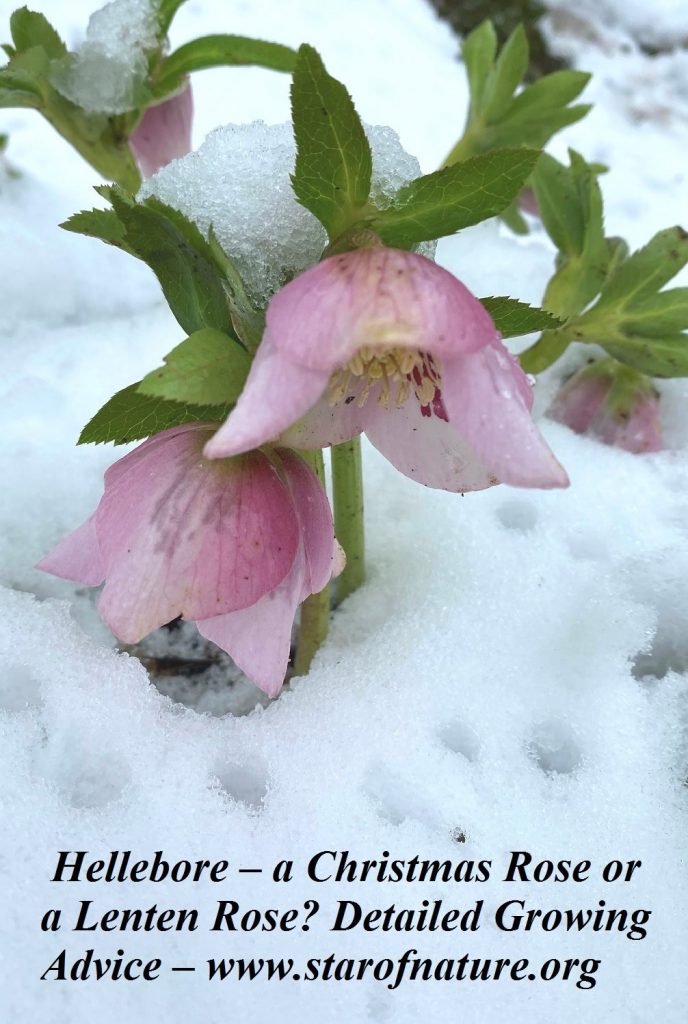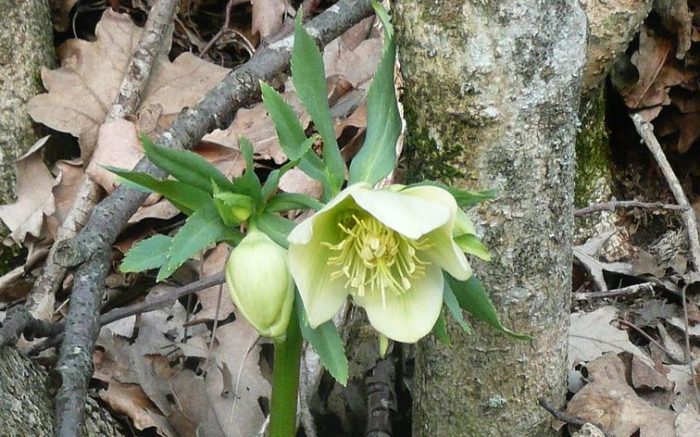Hellebore – a Christmas Rose or a Lenten Rose? Detailed Growing Advice
Hellebore is the ultimate winter flower – supremely elegant and graceful, yet hardy and able to cope with snow and cold. Its French name is Rose de noёl (‘Christmas Rose’) or Rose d’hiver (‘Winter Rose’). Hellebore flower indeed resembles a rose, particularly before it is fully open. In France and Germany it was traditionally grown in pots and given as a present at Christmas. Yet hellebore also has a connection with Easter – its English name is Lenten rose. Below I explain how to care for this beautiful plant that became a symbol of both winter and spring, and tell a little about its history.
Popular varieties
Hellebore is a perennial, native to Europe and Asia, that grows in woodland and mountainous areas in the wild. It is evergreen and hardy to -20, and is therefore suitable for zone 7. There are several hellebore varieties in cultivation.
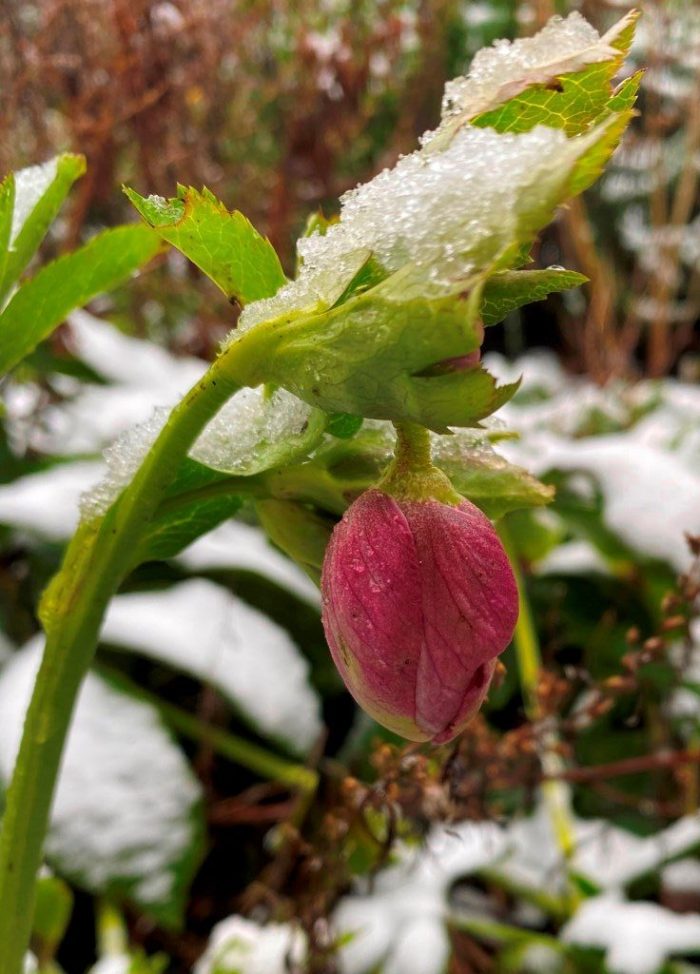
Black hellebore – Hellebore niger – Christmas Rose
When it comes to hellebore, black is actually white. The species that became known as Christmas Rose is called Helleborus niger in Latin, which means Black hellebore. Black refers to the colour of its root, the part that was used in medicine, rather than to the colour of its flower that is white or soft pink. It is one of the most beautiful hellebore varieties. Interestingly, its flowers look upwards, rather than downwards, as with most hellebores.
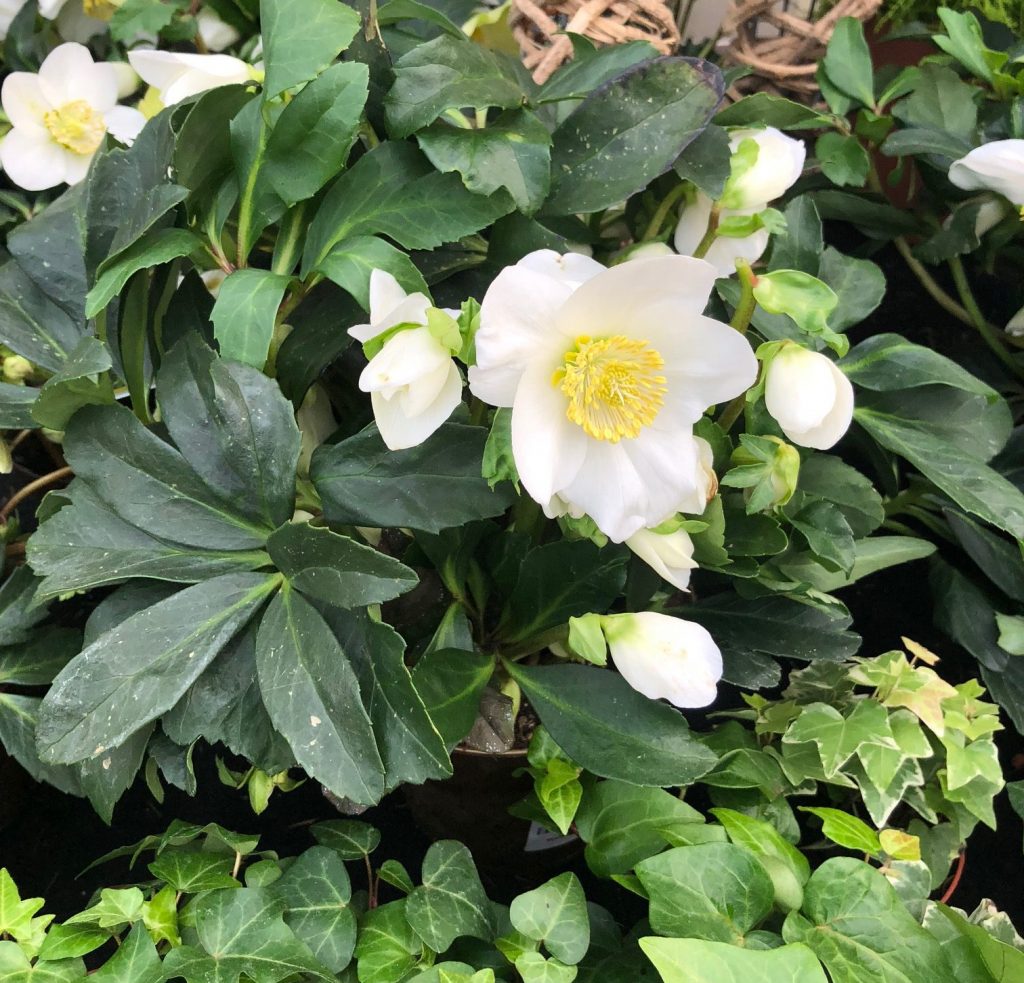
Black hellebore flowers earlier than other hellebore varieties, and is highly valued for this ability to brighten the darkest time of the year. In Central and Southern Europe, where it was once a common wild plant, it blooms with snowy white or pale pink flowers from the end of December to February. Some modern decorative varieties flower even earlier, in November. In France, Germany and Austria hellebore roots were once dug up in woods and cultivated in cold greenhouses for flowering at Christmas.
Growing advice
Hellebore niger is not the easiest plant grow, but there are a few things you can try to help it along:
- It prefers soil that is very loose, rich in organic matter and reliably moist. This is true of all hellebore plants, but Black hellebore is particularly demanding in this respect.
- Black hellebore is even less tolerant of acidity in the soil than other varieties. Some experts advise sprinkling a dose of magnesium in the form of Epsom salts or dolomitic limestone around the plants when they are establishing, and then yearly in early spring.
- The leaves of Black hellebore should not be cut in winter before flowering, as is a common practice with other hellebore plants. This is normally unnecessary because the leaves usually look good at the time of flowering.
- If you need to replant Black hellebore, it is better to do it in spring, rather than in autumn, to avoid disturbing it close to the time of its flowering.
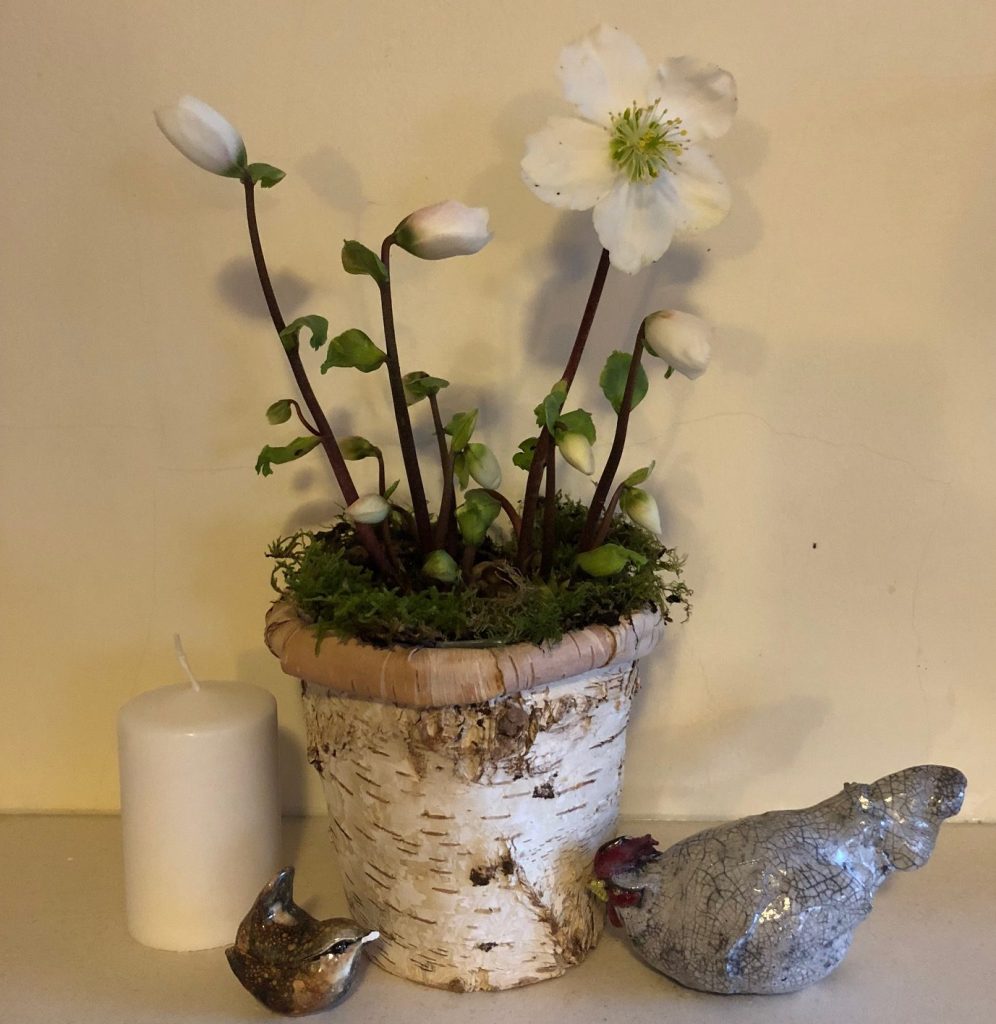
Oriental hellebore – Helleborus x hybridus (formerly Helleborus orientalis) – Lenten Rose
Oriental hellebore flowers later than Black: in mild climate this happens in January and February, in colder areas – in early spring. Its traditional English name is therefore Lenten rose – it flowers during Lent that precedes Easter.
Oriental hellebore is a strong plant growing 30-60cm tall, with evergreen leaves. It is very prolific and undemanding, and much easier to grow than Black hellebore.
Many beautiful and colourful varieties sold in garden centres in winter are modern cultivars of Oriental hellebore. They are exceptionally diverse and include double hellebores and varieties with very large flowers and striking markings, dots and blotches on petals. The colour ranges from pure white to salad green and yellow, and to all shades of pink and purple. There are cultivars with very dark leaves and dramatic nearly black flowers.
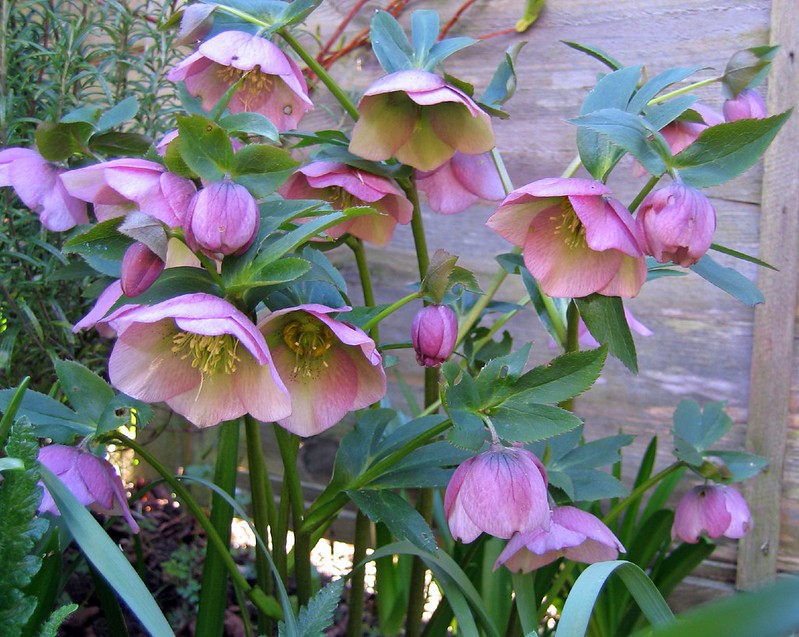
Stinking hellebore – Helleborus foetidus
Hellebore foetidus is about 60cm tall with dark green exotic looking leaves and clusters of small salad-green flowers in late winter. The contrast between a darker shade of leaves and a paler green of flowers is very beautiful. In spite of its name its flowers have no smell. It is more tolerant of poor sandy soil and dryness than other hellebore plants.
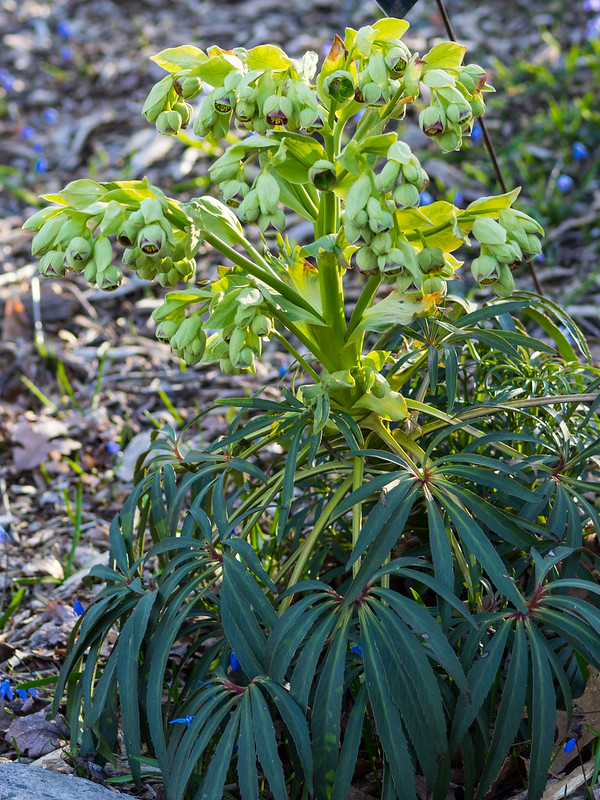
Caring for hellebores
Where to plant hellebores?
Hellebore does not like to be moved. If replanted, it takes a year to recover and flower again. It is therefore worth giving some thought to its position in the garden. The good news is that it can happily grow in the same place for many years, slowly getting bigger and producing more and more flowers. Such older clumps with 50-70 flower stems look imposing and luxurious. So it is better not to move them, unless really necessary.
Hellebore grows best in half-shade. If planted in full sun, it will do well only if it has a reliable supply of moisture. For this reason hellebores planted around ponds tend to do well. Some shade in the summer, however, is beneficial, as it stops the soil from drying out and eliminates the need for watering. If the conditions are very dry in the summer, hellebore leaves will flop and the plants will not look attractive.
Hellebore grows well under deciduous trees. In the summer they provide light shade, whereas in winter, when they are bare, hellebore gets all the sun it needs, exactly when it needs it most – at the time of flowering.
Hellebores look very effective planted in groups. They are also highly suitable for natural gardens that imitate light woodland.
What are their soil requirements?
Hellebores need soil that is loose, crumbly and rich in organic matter. It should be moist, but definitely not waterlogged.
The soil also needs to be neutral or moderately alkaline (pH 7 and above). All varieties are intolerant of acidic soil.
What to plant with hellebores?
Hellebore flowers look beautiful with early spring bulbs planted in the foreground. The bulbs could include snowdrops, winter aconites, crocuses, cyclamens, hyacinths, daffodils and tulips.
They also combine well with spring-flowering heather.
A wonderful quality of hellebores, is that they look good not only with very early flowers, but also with plants that flower later in spring. This is because hellebores look decorative for a very long time. They flower for about two weeks, but the ILLUSION of flowering continues through entire spring.
The reason for this is that hellebore flowers do not drop, but gradually fade to pale green and dry preserving their shape. As a result they look beautiful for months and combine well with plants that flower later in spring, such as forget-me-nots.
For the same reason hellebores look stunning planted around early flowering trees, particularly apples and cherries. This creates a very traditional nostalgic cottage-garden look.
When to plant hellebores?
The best time to plant is April for Black hellebore and September for other varieties. Because Black hellebore flowers so early, already in December, or even November, it is best to avoid disturbing it in autumn. For other varieties September is a good time. They will have a chance to get established before the arrival of frost and snow.
How to plant them?
Make a planting hole that is 1.5-2 times deeper and wider than the roots of the hellebore to be planted. Fill the hole with compost to half of its depth. Put the roots of the plant in the hole, cover them with soil and firm the soil around them. Hellebores should be planted at the same depth as they grew previously. Water the plant and put mulch, such as bark chippings, grass cuttings or autumn leaves around it. Keep watering, so that the soil is constantly moist for the next three weeks.
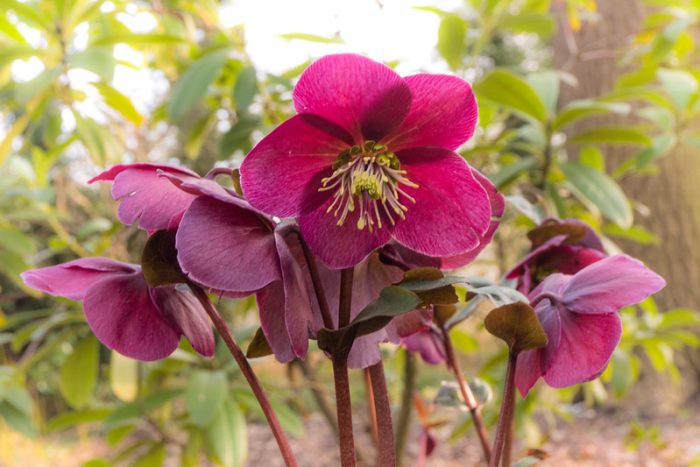
Hellebore care
Hellebore care is very simple.
- Cut down all old leaves of Oriental hellebores before flowering in mid or late winter. By the time hellebore flowers, old leaves are usually worn out and lie flat on the ground. Removing them improves the look and makes the flowers more visible. It also prevents the spread of fungal diseases that occasionally affect hellebore plants. Beautiful fresh leaves will grow back at the end of flowering. This does not apply, however, to hellebore foetidus or Black hellebore, that have more perennial leaves.
- After flowering spread mulch under plants to keep the soil moist in the summer and to improve its structure and fertility.
- Hellebores respond very well to organic fertiliser, such as bone meal. It helps them to flower more prolifically. Put a handful of it under a plant approximately once every three months during the growing season.
Transplanting hellebores
As mentioned earlier, hellebore does not like transplanting. Once moved it will take a year to recover and probably will not flower that year. If transplanting is done correctly, however, it is unlikely to die.
Prepare a planting hole in advance. Make a note of how the plant is oriented towards the sun – ideally this should be preserved when it is replanted. Dig the plant out with a clump of soil as large as possible. Hellebores have lots of thin roots that are easily damaged, and a clump of soil will help to preserve them. Carefully transport the plant to a new place. Follow the same steps as with planting, described above. Continue watering for three weeks.
The best time for transplanting is spring for Black hellebore that flowers very early in winter, and September for other hellebore varieties that flower later.
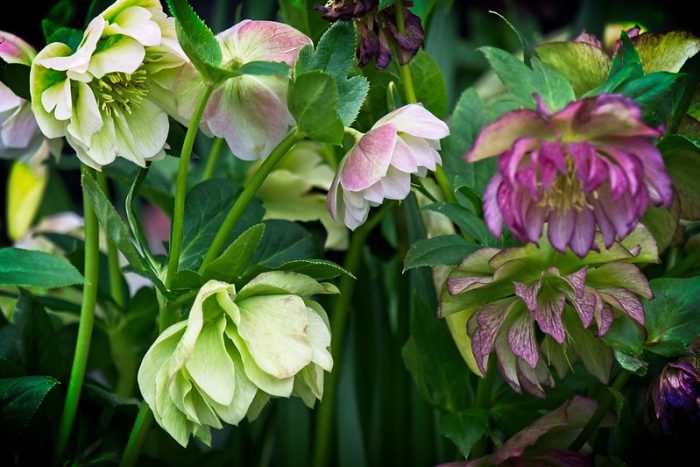
Dividing hellebore plants
Hellebore can be propagated by dividing its roots. It is the best method if a particular colour needs to be preserved, because hellebores hybridize very easily. In a garden they may all end up the same colour (usually dusty pink for Oriental varieties).
A plant should be 5 or more years old. Hellebores grow slowly and it takes several years for them to become sufficiently large for dividing. The best time for dividing is early September for Oriental and early spring, after the end of flowering, for Black hellebore.
Dig the hellebore plant out and gently shake off the soil. You will see that the roots have several growth points – points from which young leaves emerge. Using a sharp garden knife cut the clump vertically into several sections, cutting between the growth points. As a result the clump will be divided into sections, each with 2 or 3 growth points with young leaves.
Sprinkle the cuts with powered charcoal that will act as a disinfectant. Plant into holes prepared in advance. Water and keep moist if the weather is dry. It will take a year for the young plants to recover and start growing actively.
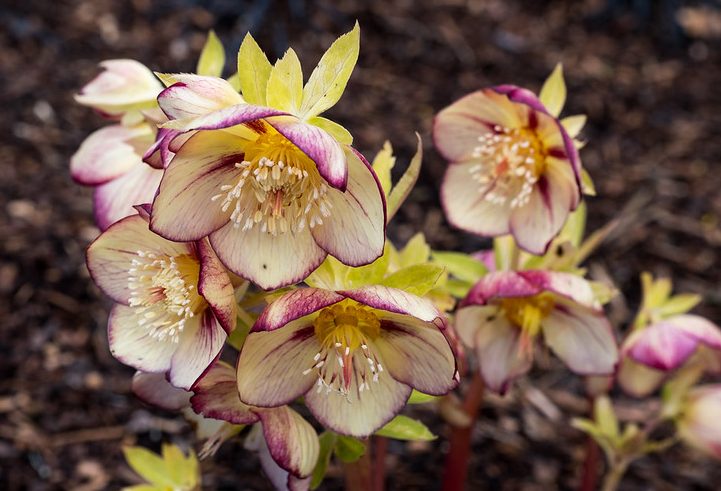
Growing hellebore from seed
Hellebore seeds start to ripen in June and continue through much of the summer. As they ripen, they are dispersed and will sprout the following spring. Hellebores self-seed very easily.
The main difficulty of propagating hellebores from seed is that their seeds do not last longer than a year. After 6 months they become 50% less viable, and after a year – nearly 100%. Another difficulty is that in order to sprout they need a warm period of dormancy (summer), followed by a cold period of dormancy (winter), just as it happens in nature.
So hellebore seeds need to be sown in late June, immediately after ripening. To collect the seeds tie a cheese cloth around some seed heads in advance, before they burst and seeds fall to the ground.
Sow the seeds thinly in drills 15cm apart. The soil should be loose, moist and rich in organic matter. Cover with 1.5cm of soil. The seedlings will appear in March next year.
Once hellebore plants have 2-3 leaves they can be moved to a ‘nursery’ to give them more space. Replant to a bed in half-shade leaving 20cm between them. Move then to their permanent positions when they are 2-3 years old, preferably in September.
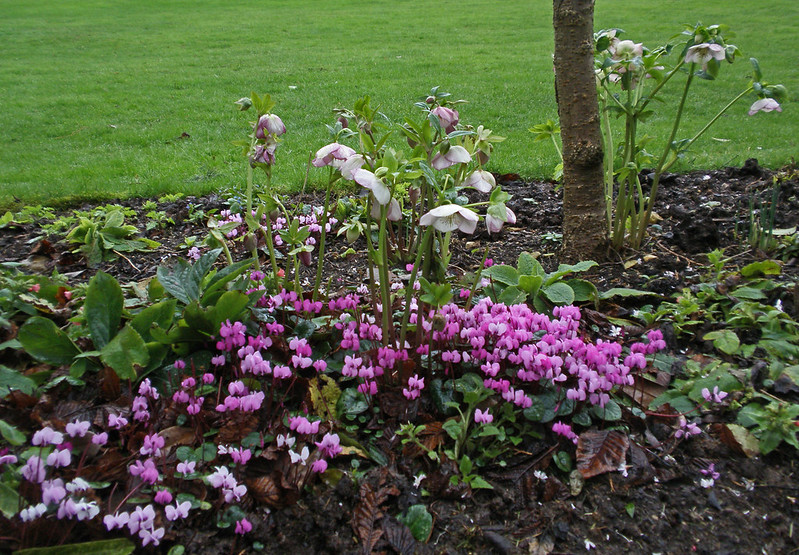
Diseases
Hellebore plants occasionally get fungal infections. This tends to happen when autumn is very wet and winter is mild. If this happens, leaves develop black and brown blotches. Such leaves should be cut and burned. If this happens regularly, remove the leaves early in autumn, in October, rather than January.
Hellebore will suffer if planted in acidic soil – their leaves will develop brown patches. Cut such leaves and make the soil more alkaline by adding lime.
Generally hellebores are very resistant to pests and diseases. Problems usually arise only if the plants are very unhappy. So try to give them comfortable conditions – mulching them regularly will on its own prevent many problems.
Growing hellebore flowers for Christmas
Black hellebores were traditionally grown in pots and used as decoration or presents at Christmas. To grow Black hellebores for Christmas, plant them in pots with good rich garden soil in September. In areas that have a lot of snow and frost, it is best to keep the pots in a cold greenhouse or shed when the weather turns very cold.
Bring them to a cool bright conservatory or a window sill in early November. Begin watering and keep constantly moist. Flower buds will start appearing at the temperature of 5-6C. Closer to the time of flowering, or to speed up the development of flowers, the temperature can be increased to 10-12C. Hellebores will grow at a higher temperature as well, but the flower stems may be weak. In spring plant in a shady place in the garden.
Is hellebore poisonous?
It is poisonous like all members of the buttercup family (Ranunculaceae). Nevertheless, like many poisonous plants, it has a long history of use in medicine. All species contain several substances that affect the heart, at first weakening and then strengthening its activity. Another substance, called helleborin, affects the nervous system. Because of this Greek, Roman and medieval physicians used hellebore to treat paralysis and insanity. Powder made from its dried root is still used in some countries to improve immunity, metabolism and for weight loss.
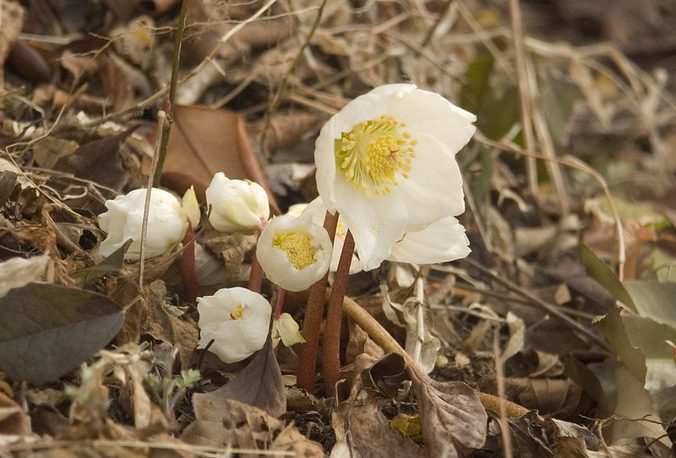
Is hellebore a chemical weapon?
Who could have thought that the Christmas or Lenten rose was used as a chemical weapon? But this did happen in a not-so-nice episode in human history.
It happened during the so-called First Sacred War. In about 590 BC, several Greek city-states created the Amphictionic League to protect the religious sanctuary of Delphi, the site of the famous Oracle of Apollo. The League attacked the city of Kirrha (modern Kirra in Phocis in Greece) which controlled the road to Delphi. It accused the citizens of Kirrha of robbing pilgrims going to Delphi and of other religious crimes.
During the siege someone came up with a plan to poison water going to Kirrha. There are several accounts of this event and most claim that the water was poisoned with hellebore plants that grew in the vicinity of Kirrha.
According to a Greek geographer Pausanias (c. 110 – c. 180), it was the famous Athenian statesman Solon. He diverted a channel from the river Pleistos, so that it no longer ran through Kirrha, depriving the citizens of water. But the citizens used wells and rainwater instead. Solon then ordered to throw a great quantity of hellebore roots into a reservoir formed by Pleistos. When the roots infused the water with poison, he sent it back into the city. Thirsty Kirrhans drank the water and became violently ill. The League troops then took the city unopposed.
Hippocratic Oath
Another account credits the plan to poison the water to a doctor named Nebros, an ancestor of the great physician Hippocrates, author of the Hippocratic Oath in the 5th century BC. According to this account, Nebros introduced a drug in an aqueduct that the besiegers accidentally discovered.
The account that implicates Nebros is the earliest known source. It was written only a century after Kirrha’s destruction and during Hippocrates’ lifetime. Modern historians speculate that this episode may have inspired Hippocrates to write his Oath. After all, it requires that doctors do not use their specialized knowledge to cause harm.
The meaning of hellebore
According to the Oxford English Dictionary, the origin of hellebore is unclear. It is probably made up of Greek words ellos ‘young deer’ and boros ‘food’. The meaning of hellebore is then ‘food of deer’. Deer were thought to recognize medicinal plants. Like other wild animals, they can also eat plants poisonous to humans, including many mushroom species.
Image credits: featured image – Green hellebore by cristina.sanvito, Hellebore orientalis by Ruth Hartnup; Hellebore foetidus by F. D. Richards, Purple hellebore orientalis by Derek Winterburn, Double hellebores by Garry Knight, Cyclamen and hellebore by Amanda Slater, Bodnant Gardens by Allan Harris, Hellebore niger by Happy Come.
Related Posts
Growing Winter Aconite – a Golden Treasure in your Garden
How to grow wild flowers in the garden
How to protect plants from frost damage in spring
Pin ‘Hellebore – a Christmas Rose or a Lenten Rose? Detailed Growing Advice’ for later
